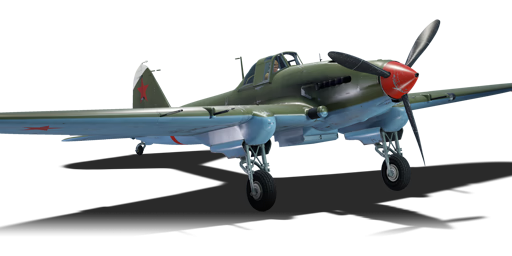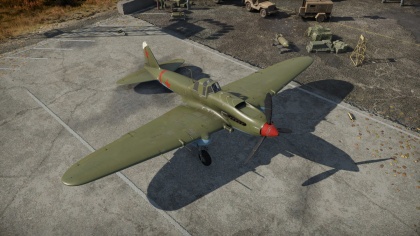Difference between revisions of "IL-2 (1942)"
(Added history.) |
(→Pros and cons) (Tag: Visual edit) |
||
| Line 131: | Line 131: | ||
=== Survivability and armour === | === Survivability and armour === | ||
<!--''Examine the survivability of the aircraft. Note how vulnerable the structure is and how secure the pilot is, whether the fuel tanks are armoured. Describe the armour, if there is any, also mention the vulnerability of other critical aircraft systems.''--> | <!--''Examine the survivability of the aircraft. Note how vulnerable the structure is and how secure the pilot is, whether the fuel tanks are armoured. Describe the armour, if there is any, also mention the vulnerability of other critical aircraft systems.''--> | ||
| + | |||
* No armour plating | * No armour plating | ||
* No armour glazing | * No armour glazing | ||
| Line 176: | Line 177: | ||
===Modules=== | ===Modules=== | ||
{| class="wikitable" | {| class="wikitable" | ||
| − | !colspan = "1"| Tier | + | ! colspan="1" | Tier |
| − | !colspan = "2"| Flight performance | + | ! colspan="2" | Flight performance |
| − | !colspan = "1"| Survivability | + | ! colspan="1" | Survivability |
| − | !colspan = "2"| Weaponry | + | ! colspan="2" | Weaponry |
|- | |- | ||
| I | | I | ||
| Line 211: | Line 212: | ||
'''Pros:''' | '''Pros:''' | ||
| + | |||
| + | * 23 different payload arrangements with bombs and rockets of varying size allow for flexible ground attack options. | ||
| + | * Powerful pair 23mm VYa canons increase available firepower while retaining ample ammo capacity. | ||
| + | * Strong protection surrounds the pilot and engine. | ||
| + | * Can be used as a makeshift fighter. | ||
| + | |||
* | * | ||
'''Cons:''' | '''Cons:''' | ||
| + | |||
| + | * Lacks defensive armament. | ||
| + | * Heavy plane. | ||
| + | * Can't carry bombs larger than 250kg makes it hard to destroy more than one target. | ||
| + | * (SB) Restricted visibility from inside. | ||
| + | * Higher battle rating. | ||
| + | |||
* | * | ||
| Line 228: | Line 242: | ||
== Read also == | == Read also == | ||
''Links to the articles on the War Thunder Wiki that you think will be useful for the reader, for example,'' | ''Links to the articles on the War Thunder Wiki that you think will be useful for the reader, for example,'' | ||
| + | |||
* ''reference to the series of the aircraft;'' | * ''reference to the series of the aircraft;'' | ||
* ''links to approximate analogues of other nations and research trees.'' | * ''links to approximate analogues of other nations and research trees.'' | ||
| Line 234: | Line 249: | ||
== Sources == | == Sources == | ||
''Paste links to sources and external resources, such as:'' | ''Paste links to sources and external resources, such as:'' | ||
| + | |||
* ''topic on the official game forum;'' | * ''topic on the official game forum;'' | ||
* ''page on aircraft encyclopedia;'' | * ''page on aircraft encyclopedia;'' | ||
Revision as of 16:20, 8 May 2019
Contents
| This page is about the Russian attacker IL-2 (1942). For other uses, see IL-2 (Family). |
Description
The IL-2 (1942) is a rank II Russian attacker
with a battle rating of 3.0 (AB/RB) and 2.7 (SB). This attacker has been in the game since the start of the Open Beta Test prior to Update 1.29.
General info
Flight Performance
| Characteristics | |||||||
|---|---|---|---|---|---|---|---|
| Stock | |||||||
| Max Speed (km/h at ?,000 m) |
Max altitude (meters) |
Turn time (seconds) |
Rate of climb (meters/second) |
Take-off run (meters) | |||
| AB | RB | AB | RB | AB | RB | ||
| ? | ? | 9500 | ??.? | ??.? | ??.? | ??.? | ??? |
| Upgraded | |||||||
| Max Speed (km/h at ?,000 m) |
Max altitude (meters) | Turn time (seconds) | Rate of climb (meters/second) |
Take-off run (meters) | |||
| AB | RB | AB | RB | AB | RB | ||
| ? | ? | 9500 | ??.? | ??.? | ??.? | ??.? | ??? |
Details
| Features | ||||
|---|---|---|---|---|
| Combat flap | Take-off flap | Landing flap | Air brakes | Arrestor gear |
| X | X | X | X | X |
| Limits | ||||
|---|---|---|---|---|
| Wing-break speed (km/h) |
Gear limit (km/h) |
Combat flap (km/h) |
Max Static G | |
| + | - | |||
| 620 | 320 | ??? | ~?? | ~? |
| Optimal velocities | |||
|---|---|---|---|
| Ailerons (km/h) |
Rudder (km/h) |
Elevators (km/h) |
Radiator (km/h) |
| < ??? | < ??? | < ??? | > ??? |
| Compressor (RB/SB) | ||
|---|---|---|
| Setting 1 | ||
| Optimal altitude | 100% Engine power | WEP Engine power |
| ?,??? m | ??? hp | ?,??? hp |
Survivability and armour
- No armour plating
- No armour glazing
- Critical components located at the front of aircraft (fuel, pilot, engine, controls)
- More fuel tanks located in wings near the fuselage
Armaments
Offensive armament
Main article: Bombs-->
Usage in the battles
Manual Engine Control
| MEC elements | ||||||
|---|---|---|---|---|---|---|
| Mixer | Pitch | Radiator | Supercharger | Turbocharger | ||
| Oil | Water | Type | ||||
| Controllable | Not controllable | Not controllable | Not controllable | Separate | Not ontrollable | Not controllable |
Modules
| Tier | Flight performance | Survivability | Weaponry | ||
|---|---|---|---|---|---|
| I | Fuselage Repair | Radiator | |||
| II | Compressor | Airframe | |||
| III | Wings Repair | Engine | |||
| IV | Engine Injection | Cover | |||
Pros and cons
Pros:
- 23 different payload arrangements with bombs and rockets of varying size allow for flexible ground attack options.
- Powerful pair 23mm VYa canons increase available firepower while retaining ample ammo capacity.
- Strong protection surrounds the pilot and engine.
- Can be used as a makeshift fighter.
Cons:
- Lacks defensive armament.
- Heavy plane.
- Can't carry bombs larger than 250kg makes it hard to destroy more than one target.
- (SB) Restricted visibility from inside.
- Higher battle rating.
History
The famous IL-2 Sturmovik was a Soviet WWII-era attack aircraft created by the Ilyushin Design Bureau and nicknamed Hunchback by Red Army troops due to the distinct fuselage shape. While the designers nicknamed their aircraft the Flying Tank, Luftwaffe pilots, due to the IL-2's incredible ability to withstand battle damage, instead called it the Betonflugzeug (Concrete Plane). German ground troops, conversely, despised and feared the IL-2, giving it a slew of unpleasant nicknames, such as Schlachter (Butcher); Fleischwolf (Meatgrinder); Eiserner Gustav (Iron Gustav) and Schwarzer Tod (the Black Death). Some historians believe that the Black Death was actually a successful invention of the Soviet propaganda machine that caught on with the Germans.
The IL-2 was the most mass-produced military aircraft in history. However, early in the war German air superiority coupled with the absence of rear gunners on early variants and poorly organized Soviet fighter escorts led to high rates of losses for the type. A favourite attack tactic for IL-2 pilots was a low-level attack run, first letting loose with rockets at 600-700 meters, then firing onboard armament from a distance of 400 to 600 meters. Bombs would be dropped in subsequent passes from an altitude of 100-200 meters, using an impact fuse. The recommended tactic for attacking concentrations of soft targets was a strafing run in a shallow dive from 100-200 meters and a subsequent dropping of bombs at a low level when exiting the dive.
Media
An excellent addition to the article will be video guides, as well as screenshots from the game and photos.
Read also
Links to the articles on the War Thunder Wiki that you think will be useful for the reader, for example,
- reference to the series of the aircraft;
- links to approximate analogues of other nations and research trees.
Sources
Paste links to sources and external resources, such as:
- topic on the official game forum;
- page on aircraft encyclopedia;
- other literature.
| USSR strike aircraft | |
|---|---|
| IL-2 | IL-2 (1941) · IL-2 (1942) · IL-2M (1943) · IL-2M type 3 · IL-2M "Avenger" · IL-2-37 · IL-2 M-82 |
| IL-8 | IL-8 (1944) |
| IL-10 | IL-10 · IL-10 (1946) |
| Pe-3 | Pe-3 (e) · Pe-3 · Pe-3bis |
| Su-2 | BB-1 · Su-2 MV-5 · Su-2 TSS-1 · Su-2 (M-82) |
| Su-6 | Su-6 · Su-6 (AM-42) · Su-6 (M-71F) |
| Su-8 | Su-8 |
| Tandem MAI | Tandem MAI |
| TIS MA | TIS MA |
| Tu-1 | Tu-1 |
| Yak-2 | Yak-2 KABB |





